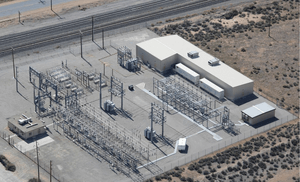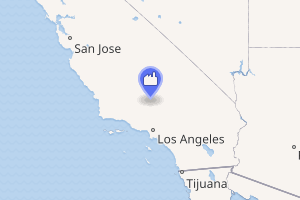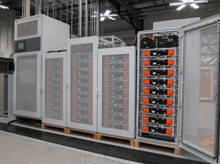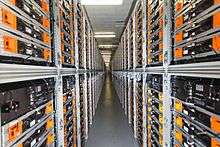Tehachapi Energy Storage Project
The Tehachapi Energy Storage Project (TSP) is a lithium-ion battery-based grid energy storage system at the Monolith Substation of Southern California Edison in Tehachapi, California. At the time of commissioning in 2014, it was the largest lithium-ion battery system operating in North America and one of the largest in the world.[1][2][3][4] The TSP system can supply 32 megawatt-hours of energy, at a maximum rate of 8 megawatts. This is sufficient to power between 1,600 and 2,400 homes for four hours.[5] TSP is considered to be a modern-day energy storage pioneer with significant accomplishments that have proven the viability of utility-scale energy storage using lithium-ion technology.[6] While originally envisioned as a research and development project,[7] TSP continues operation today as a distribution-level resource for Southern California Edison.[8]
| Tehachapi Energy Storage Project | |
|---|---|
 Overhead View of Tehachapi Energy Storage Project, Tehachapi, CA | |

| |
| Country | United States |
| Location | Tehachapi, Kern County, CA |
| Coordinates | 35°7′24″N 118°22′48″W |
| Status | Operational |
| Construction began | 2013 |
| Commission date | 2014 |
| Owner(s) | Southern California Edison |
| Operator(s) | Southern California Edison |
| Power generation | |
| Nameplate capacity | 8 MW |
| Storage capacity | 32 MWh |
| External links | |
| Website | https://newsroom.edison.com/releases/sce-unveils-largest-battery-energy-storage-project-in-north-america |
System
In May 2013, Southern California Edison awarded the TSP contract to a consortium led by LG Chem, the battery division of the South Korean industrial conglomerate LG Corporation. LG Chem supplied the battery systems while ABB Group supplied the inverters and LG CNS provided the engineering and construction support.[4]
The TSP system was one of the first to demonstrate the assembly of a large quantity of lithium-ion batteries into a single system on the order of megawatts of power and tens of megawatt-hours of energy to provide electric grid support. The project uses electric vehicle-grade batteries and demonstrates the synergies between batteries for the automotive and electric grid sectors.[9] During 2009 to 2014, more than 120 grid energy storage projects were commissioned, marking a significant turning point for grid batteries.[10] The TSP system had a significant role in this as a large, utility-owned system providing multiple energy services using commercially available products.[10]
The TSP system was designed and evaluated using an application-driven approach.[11] Energy storage for the wind farms at Tehachapi Pass[12] have been extensively studied before, including the impacts of energy storage at Monolith Substation.[13] As Edison International, parent company of Southern California Edison (SCE), describes, there is a continued interest in energy storage from utilities, along with a view that there will be technical innovations to help with managing the grid in a more efficient and reliable manner.[14]
The history of seismic activity in Kern County,[15] including damage to substation structures,[16] created some challenging system design requirements, such as having the populated battery racks designed and tested to meet IEEE 693-2005, Recommended Practice for Seismic Design of Substations recommendations.[17][18] Since commissioning in 2014, the area has experienced not only seismic activity,[19] but also flash floods and subsequent mudslides.[20]
One key lesson learned is the importance of subscale testing by the electric utility prior to full system deployment so that the safety and operational controls and features could be fully evaluated.[21][22] This was the first known use of a subscale system by an entity other than a manufacturer or integrator to facilitate full-scale testing, commissioning, and ongoing operations.[6] The mini-system test plan included two phases:
- Performing safety testing on the expected behavior of the batteries and battery management system during interruptions to communication paths during system startup and operation and
- Performing system acceptance tests on the Mini-System to verify correct operation of the control algorithms, test modes, and system response prior to performing the same tests on the full system.[6]
The original mini-system provided engineers with support for full system startup and commissioning, but, with only one battery section and one inverter lineup, engineers were unable to test the multi-inverter lineup-battery section operation of the system in the laboratory, such as inter-section balancing controls, multi-inverter operation, and symmetrical and unsymmetrical operation of the inverter lineups.[6] To more closely resemble the full system, the mini-system was expanded in December 2015 to include twice the number of each component, resulting in a system with two inverter controllers, inverter lineups, and battery sections.[6]

The TSP system is constructed of 608,832 lithium-ion battery cells that are enclosed into 10,872 modules of 56 cells each and then stacked in 604 racks.[1][21] A bi-directional inverter or power conversion system (PCS) provides the DC-to-AC conversion during battery discharging and AC-to-DC conversion for battery charging.[21] The batteries are housed in a 6,300-square-foot (590 m2) building.[23] The TSP system can supply 32 megawatt-hours of energy, at a maximum rate of 8 megawatts. This is sufficient to power between 1,600 and 2,400 homes for four hours.[5] The amount of energy stored at TSP is equivalent to that stored in more than 2,000 Chevrolet Volt hybrid electric vehicles.[24]

| Specifications for mini-system and full system[6][25] | |||
|---|---|---|---|
| Mini-System at Pomona, CA (Original) | Mini-System at Pomona, CA (December 2015 Expansion) | Full System at Tehachapi, CA | |
| Footprint | 77 square feet | 154 square feet | 6300-square-foot building |
| Power | 30 kW | 60 kW | 8 MW |
| Energy | 116 kWh | 232 kWh | 32 MWh |
| Inverter | One mini-cabinet | Two mini-cabinets | Two 40-foot containers |
| Sections | 1 | 2 | 4 |
| Banks | 1 | 2 | 32 |
| Racks | 2 | 4 | 604 |
| Modules | 36 | 72 | 10,872 |
| Cells | 2,016 | 4,032 | 608,832 |
Deployment
TSP is an example of commercially available large-scale energy storage for electric grid applications[26] and part of the increasing fleet of energy storage systems.[27] The deployment of TSP has been part of the key foundation in developing energy storage in California[28] and for increasing grid reliability overall.[29] TSP is also providing improved integration and opportunities for better operation of renewable energy resources.[30]
In 2014, TSP was one of the large-scale energy storage projects in the interconnection queue for the California Independent System Operator (CAISO) with planned benefits including firming renewable generation, frequency regulation, spin and non-spin replacement reserves, ramp management, and energy price arbitrage.[31] The TSP system was tested using eight core tests performed by the grid operator or under market control.[32] Some of the lessons learned included the challenges related to outage scheduling, challenges with interconnection agreements, benefits of component validation testing at the factories, and preparing detailed step-by-step test plans in advance.[25] Both the utility and system provider gained important perspectives and insights during the design, construction, commissioning, and operating of the TSP system.[33][6][17]
To evaluate the 13 operational uses, SCE defined eight tests to measure the ability of TSP to respond to the following system needs or signals:
- Provide steady state voltage regulation at the local Monolith 66 kV bus
- Provide steady state voltage regulation at the local Monolith 66 kV bus while performing any other tests
- Charge during periods of high wind and discharge during low wind under SCE system operator control
- Charge during off-peak periods and discharge during on-peak periods under SCE system operator control
- Charge and discharge seconds-to-minutes as needed to smooth intermittent generation in response to a real-time signal
- Respond to CAISO control signals to provide frequency response
- Respond to CAISO control signals to provide spin and non-spin reserves
- Follow a CAISO market signal for energy price.[6]
| Tehachapi Operational Uses and Tests[25] | ||||||||||
|---|---|---|---|---|---|---|---|---|---|---|
| Operational Use | Test | |||||||||
| 1 | 2 | 3 | 4 | 5 | 6 | 7 | 8 | |||
| Transmission | Voltage Support | 1 | X | X | ||||||
| Decreased Losses | 2 | X | ||||||||
| Diminished Congestion | 3 | X | ||||||||
| Increased System Reliability | 4 | X | ||||||||
| Deferred Transmission Investment | 5 | X | X | |||||||
| Optimized Renewable-Related Transmission | 6 | X | X | |||||||
| System | System Capacity/Resource Adequacy | 7 | X | X | ||||||
| Renewable Integration (firming & shaping) | 8 | X | ||||||||
| Output Shifting | 9 | X | ||||||||
| ISO Market | Frequency Regulation | 10 | X | |||||||
| Spin and Non-Spin Reserves | 11 | X | ||||||||
| Deliver Ramp Rate | 12 | X | X | |||||||
| Energy Price Arbitrage | 13 | X | ||||||||
The final project report for the United States Department of Energy after system deployment concludes that TSP is a modern-day energy storage pioneer, achieving a number of significant accomplishments that have proven the viability of utility-scale energy storage using lithium-ion technology.[6] These accomplishments include:[6]
- The largest lithium-ion battery energy storage system in North America in terms of energy capacity (32 MWh) at the time of commissioning in 2014
- The first battery energy storage system in California specifically designed and operated as a dual-use asset, supporting utility transmission and distribution functions and operating in the competitive power market
- The first known use of a subscale or mini-system by an entity other than a manufacturer or integrator to facilitate full scale testing, commissioning, and ongoing operations
- The first battery energy storage system integrated with SCE’s systemwide Supervisory Control and Data Acquisition (SCADA) system providing high-level visibility and control to grid operators
- The first battery energy storage system to be operated by SCE and one of the first to be interconnected, certified, and operated in the CAISO market
- The first modern, large-scale, lithium-ion battery energy storage system installed in an SCE substation and connected to the regional transmission network
- Serving as the foundation for subsequent SCE energy storage procurements

Operation
Since the start of market operations in 2016, TSP has been listed in the Monthly Electric Generator Inventory of the Energy Information Administration (EIA) as an electric generator.[34] During that time period, the EIA began publishing more-detailed energy storage information in its Annual Electric Generator Report, including battery capacity, charge and discharge rates, storage technology types, reactive power ratings, storage enclosure types, and expected usage applications.[35]
The operation of the TSP system has been described as a real-life example of grid-connected energy storage,[36] and some of the initial testing included storing wind energy at night and delivering it during the day when customers need it.[37] The California Independent System Operator (CAISO), a grid system operator, shares its operating experiences of TSP internationally with other grid operators as part of continued close collaborations.[38] The ongoing operation of the TSP system continues to provide grid services in the energy market and lessons learned for grid energy-storage systems.[39][40]
Analysis
One of the major benefits of the TSP system is the wide range of studies and analyses performed by multiple organizations to address various aspects of the energy market. Operational information has been used as part of developing incentives for distributed energy storage for California, New York, Hawaii, and several other states.[41] The energy management system (EMS) and EMS structure for TSP have been studied to develop and determine the technical, market, and regulatory requirements for energy-storage systems.[42]
The University of California, Riverside has used TSP for the stochastic valuation of energy storage in wholesale power markets to determine optimal power dispatch sequences.[43] The findings from this study include:
- System performance is heavily affected by roundtrip effiency and power-to-energy ratio.
- The optimal power-to-energy ratio for wholesale power market is much higher than the nominal configuration of 1-to-4 typically used in existing energy storage projects.
- The majority of revenues are from frequency regulation services.[44]
In a separate analysis, the University of California, Riverside used real market data from TSP to develop an optimal supply and demand bidding, scheduling, and deployment design framework based on the day-ahead and real-time market prices, location, size, efficiency, lifetime, and charge and discharge rates.[45] The topic of used and second-use batteries is also examined and analysis shows that by using one of the proposed bidding methods, TSP could still be profitable even after losing half of its energy capacity.[45]
Based on the studies described above, the University of California, Riverside performed an additional analysis for the scenarios where battery systems are investor-owned and independently operated and participating in existing markets.[46] The study proposes a new optimization framework to coordinate the operation of large, price-maker, and geographically dispersed energy storage systems in a nodal transmission-constrained energy market.[46]
The Edison Electric Institute (EEI), which represents all investor-owned utilities in the United States, has described how TSP has capabilities to provide nearly instantaneous maximum capacity for renewables ramping, which minimizes needs for traditional backup generators.[47]
The European Commission performs an ongoing analysis of energy storage systems, including TSP, and has global collaborations with technical experts to exchange and to learn about operating details, challenges, and best practices.[48]
Awards and accolades
An official ribbon-cutting ceremony, site tour, and presentation of a certificate of recognition from the California State Senate were held on September, 24, 2014.[2][49][50] The ceremony speakers included Doug Kim (Director of Advanced Technology, Southern California Edison), Zack Scrivner (Supervisor, Kern County Board of Supervisors), Dr. Imre Gyuk (Energy Storage Program Manager, United States Department of Energy), Dr. Seokhwan Kwak (Vice President of Marketing, LG Chem), and Romeo Agbalog (Office of State Senator, Jean Fuller – 18th District).[50] Tours of the control room, battery room, and inverter enclosures were provided.[49][50]
Upon commissioning, TSP was selected as a finalist for the 2014 Innovation Award for Energy Storage North America (ESNA).[51] TSP is a member of the ESNA Hall of Fame.[52] In 2016, the California Energy Storage Alliance featured TSP in the lead position in a video with policymakers, utility executives, and energy storage pioneers titled Gamechangers: How Energy Storage Transforms the Power System, which describes how SCE pioneered the use of grid energy storage.[53]
The 2018 and 2019 Economic Round Table Reports from the Greater Antelope Valley Economic Alliance include TSP as a highlight in the Renewable Energy sections.[54] Kern County, California describes TSP as a key feature in its renewable energy portfolio[55] for storing energy from solar power and wind power and improving grid flexibility and reliability.[56] Kern County continues to cultivate energy storage as providing economic development opportunities for 2020 and beyond.[57] In 2019, the U.S. Department of Energy featured TSP in Success Stories Spotlight: Solving Industry’s Energy Storage Challenges.[58]
References
Citations
- International.
- BakersfieldNow Staff (2014-09-23). "Large battery-energy storage project unveiled in Tehachapi". KBAK – BakersfieldNow – Channel 58. Retrieved 2020-05-11.
- "VIDEO: LG Chem switches on 32 MWh energy storage system in California". POWERGrid International. 2014-09-26. Retrieved 2020-05-13.
- Business.
- Loving, Bill. "SCE Unveils Largest Battery for Storing Electricity in North America". Energized by Edison. Retrieved 2020-05-10.
- Pinsky, Naum; O'Neill, Lori (2017-03-31). "Tehachapi Wind Energy Storage Project – Technology Performance Report #3". U.S. Department of Energy – National Energy Technology Laboratory. doi:10.2172/1349233.
- Gaillac, Loïc; Castaneda, Juan; Edris, Abdel-Aty; Elizondo, David; Wilkins, Carl; Vartanian, Charlie; Mendelsohn, David (May 2012). "Tehachapi Wind Energy Storage Project: Description of operational uses, system components, and testing plans". IEEE PES T&D 2012: 1–6. doi:10.1109/TDC.2012.6281676.
- "Energy Storage | Edison International". Southern California Edison. Retrieved 2020-05-10.
- Silverstein, Ken (2014-10-12). "Electric cars have batteries. Why not power plants?". Christian Science Monitor. ISSN 0882-7729. Retrieved 2020-05-16.
- Hart, David; Sarkissian, Alfred (June 2016). "Deployment of Grid-Scale Batteries in the United States" (PDF). George Mason University – Prepared for Office of Energy Policy and Systems Analysis – U.S. Department of Energy.
- Rittershausen, Johannes; McDonagh, Mariko. "Moving Energy Storage from Concept to Reality: Southern California Edison's Approach to Evaluating Energy Storage" (PDF). Southern California Edison.
- "Tehachapi Scenic Self-Guided Wind Farm Tour" (PDF). Greater Tehachapi Chamber of Commerce.
- Muljadi, E.; Butterfield, C.P.; Yinger, R.; Romanowitz, H. (January 5–8, 2004). "Energy Storage and Reactive Power Compensator in a Large Wind Farm" (PDF). 42nd AIAA Aerospace Sciences Meeting and Exhibit.
- Strassel, Kim (March 26, 2015). "ECO:nomics: Developing Better Energy Storage". The Wall Street Journal.
- Editor, Claudia Elliott. "Now & Then: Remembering the quake of 1952". Tehachapi News. Retrieved 2020-05-17.CS1 maint: extra text: authors list (link)
- United States Earthquakes. U.S. Department of the Interior, Geological Survey. 1963.
- Gaillac, Loic; Fok, Kevin (April 2015). "Energy Storage: New Capabilities for the Electric Grid – The Tehachapi Energy Storage Project". Next Generation Batteries 2015.
- "693-2005 – IEEE Recommended Practice for Seismic Design of Substations". standards.ieee.org. Retrieved 2020-05-30.
- "United States Geological Survey (USGS) Earthquakes". earthquake.usgs.gov. Retrieved 2020-05-17.
- The Bakersfield Californian Media. "Highway 58 to remain closed at least through weekend". The Bakersfield Californian. Retrieved 2020-05-17.
- Southern California Edison. "California Public Utilities Commission: SCE Energy Storage Experience TSP & ISGD Program". California Public Utilities Commission.
- Irwin, Mark (June 12, 2014). "Energy Storage Demonstration Programs at Southern California Edison" (PDF). Association of Energy Engineers SoCal: Chapter Meetings.
- "Tehachapi Storage Project". Edison International: Newsroom.
- McFerron, Whitney (October 14, 2014). "Giant Battery Unit Aims at Wind Storage Holy Grail: Commodities". Bloomberg.
- Bender, Donald; Byrne, Raymond; Borneo, Daniel (June 2015). "Sandia National Laboratories Report: ARRA Energy Storage Demonstration Projects: Lessons Learned and Recommendations" (PDF).
- McMahon, Richard; Infante, Lola (2017-05-22). "Harnessing the Potential of Energy Storage". Power Engineering. Retrieved 2020-05-10.; Silverstein, Ken (April 21, 2017). "Energy Storage And Demand Response Propel California Forward On Earth Day". Forbes. Retrieved 2020-05-10.
- Nikolewski, Rob (2016-08-29). "Energy storage is taking on a greater role in the power grid. But how big can it get?". San Diego Union-Tribune. Retrieved 2020-05-14.
- Magill, Bobby (January 13, 2015). "California Takes Lead In Developing Energy Storage". Climate Central.
- Mora, Manuel Avendaño. "Energy Storage for Enhancing Grid Reliability" (PDF). University of California, Riverside: 2019 Energy Storage Technologies and Applications Conference.
- Yan, Joseph (March 12, 2015). "Reliability and Affordability: Challenges and Opportunities of Integrating Renewables" (PDF). Center for Ultra-Wide-Area Resilient Electric Energy Transmission Networks (CURRENT), a National Science Foundation (NSF) Engineering Research Center: Strategic Planning Meeting, March 12-13, 2015.
- "California ISO: Fast Facts: Large Scale Energy Storage Pilots" (PDF). 2014.
- Davis, Grant (September 21–24, 2015). "Tehachapi Wind Energy Storage Project" (PDF). U.S. DOE/OE Energy Storage Program Peer Review, EESAT 2015 Technical Conference.
- Irwin, Mark (November 12, 2014). "The Future of Energy Storage". Kern County Energy Summit 2014.
- "Preliminary Monthly Electric Generator Inventory (based on Form EIA-860M as a supplement to Form EIA-860)". United States Energy Information Administration. Retrieved 2020-05-24.
- "Batteries perform many different functions on the power grid – Today in Energy – U.S. Energy Information Administration (EIA)". www.eia.gov. Retrieved 2020-05-24.
- Wu, Fu-Bao; Yang, Bo; Ye, Ji-Lei, eds. (2019-01-01), "Chapter 6 – Application of energy storage technology in grid-connected new energy power generation", Grid-scale Energy Storage Systems and Applications, Academic Press, pp. 203–241, doi:10.1016/b978-0-12-815292-8.00006-x, ISBN 978-0-12-815292-8, retrieved 2020-05-10
- Ifill, Gwen; O'Brien, Miles (2015-12-15). "How building a better battery would change the game for renewable energy". PBS NewsHour. Retrieved 2020-05-14.
- California Independent System Operator (CAISO); Renewables Grid Initiative (October 2019). "Energy Storage: Perspectives from California and Europe, Discussion Paper – October 2019" (PDF). California Independent System Operator.
- Rollo, Jay; Sands, Marco. "Lessons from the Energy Storage Trenches". DISTRIBUTECH International 2020. Retrieved 2020-05-10.
- Enslin, Johan; Fok, Kevin. "Energy Storage Experiences in California". DISTRIBUTECH International 2020. Retrieved 2020-05-12.
- Breslau, Lindsay; Croweak, Michael; Witt, Alan (2017-10-24). "Batteries Included: Incentivizing Energy Storage". Sustainable Development Law & Policy. 17 (2).
- Byrne, Raymond H.; Nguyen, Tu A.; Copp, David A.; Chalamala, Babu R.; Gyuk, Imre (2018). "Energy Management and Optimization Methods for Grid Energy Storage Systems". IEEE Access. 6: 13231–13260. doi:10.1109/ACCESS.2017.2741578. ISSN 2169-3536.
- Yu, Nanpeng (May 3–5, 2016). "Stochastic Valuation of Energy Storage Systems" (PDF). IEEE/PES Transmission and Distribution Conference and Exposition.CS1 maint: date format (link)
- Yu, Nanpeng; Foggo, Brandon (March 18, 2017). "Stochastic valuation of energy storage in wholesale power markets" (PDF). Energy Economics. 64 (2017): 177–185.
- Mohsenian-Rad, Hamed (January 2016). "Optimal Bidding, Scheduling, and Deployment of Battery Systems in California Day-Ahead Energy Market". IEEE Transactions on Power Systems. 31 (1): 442–453. doi:10.1109/TPWRS.2015.2394355. ISSN 0885-8950.
- Mohsenian-Rad, Hamed (January 2016). "Coordinated Price-Maker Operation of Large Energy Storage Units in Nodal Energy Markets". IEEE Transactions on Power Systems. 31 (1): 786–797. doi:10.1109/TPWRS.2015.2411556. ISSN 0885-8950.
- Edison Electric Institute (October 2018). "U.S. Electric Company Investment and Innovation in Energy Storage" (PDF). Edison Electric Institute.
- Schledde, Dominik (August 15, 2018). "Support to R&D Strategy for battery based energy storage: Technical analysis of ongoing projects (D12)" (PDF). European Commission Directorate General Energy.
- Smirnoff, Nick. "Grand Opening of the Tehachapi Energy Storage Project". The Loop Newspaper. Retrieved 2020-05-12.
- "Ribbon-Cutting for Southern California Edison Tehachapi Energy Storage Project". From Edison International: Energy Storage. September 24, 2014.
- Energy Storage North America (ESNA) (Aug 18, 2014). "Energy Storage North America Names Top Nine Energy Storage Project Finalists". PR Newswire. Retrieved 2020-05-29.
- "Energy Storage North America Hall of Fame". Energy Storage North America. Retrieved 2020-05-27.
- "Gamechangers: How Energy Storage Transforms the Power System". Energy Storage North America. February 22, 2016.
- "2018 Economic Round Table Report" (PDF). Greater Antelope Valley Economic Alliance. 2018.; "2019 Economic Round Table Report" (PDF). Greater Antelope Valley Economic Alliance. 2019.
- Meredith, Kasey. "KEDC's Economic Summit highlights Kern's best assets". The Bakersfield Californian. Retrieved 2020-05-14.
- "Market Overview". Kern Economic Development Corporation. 2019–2020. Retrieved 2020-05-10.CS1 maint: date format (link)
- Jackson, Cara. "What's up in town? Art, hospital news and economic growth tackled at EDC meeting". Tehachapi News. Retrieved 2020-05-23.
- U.S. Department of Energy Office of Technology Transitions (July 2019). "Solving Challenges in Energy Storage" (PDF).
Bibliography
- "SCE Unveils Largest Battery Energy Storage Project in North America". Edison International. Retrieved 2020-05-10.
- "North America's Largest Battery Energy Storage System Now Operational". www.businesswire.com. 2014-09-24. Retrieved 2020-05-12.